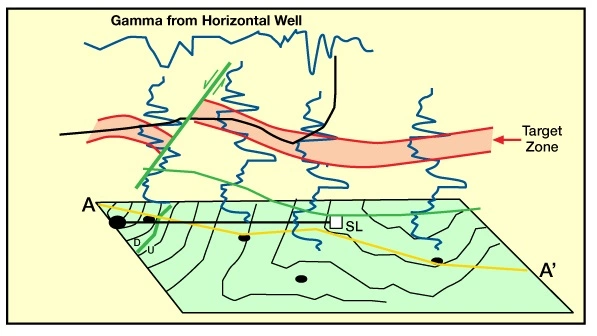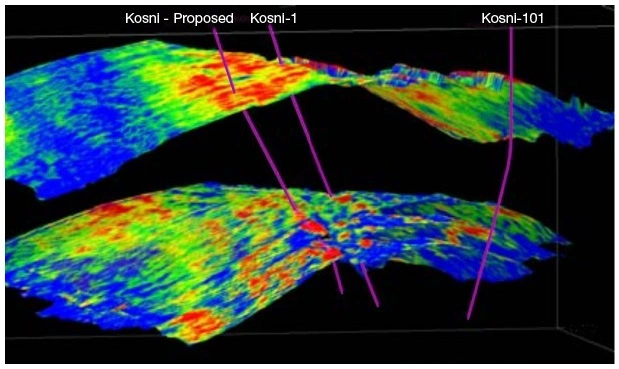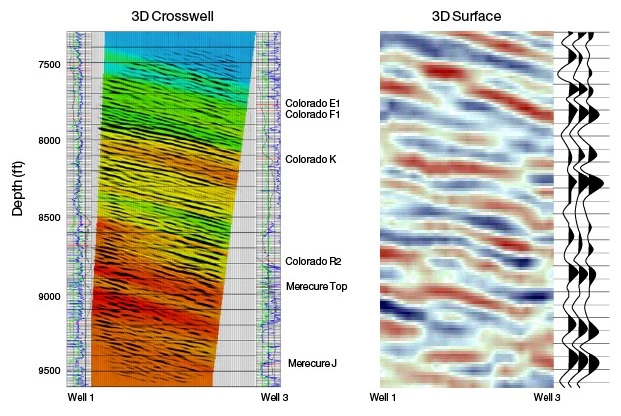Where to Pick
Determining where to pick the horizons in seismic requires knowledge and skill. Initially, we should stress the importance of looking at all the seismic data of the survey, and of getting an overall feeling for the behavior and character of important and key reflectors over the whole area.
One of the functions of wavelet processing is to shape the reflection pulse to a form that is symmetrical about the maximum of its envelope. Figure 1 will help us explain this process. A discrete reflection, like that in image A before wavelet processing, would look like image B after this part of the wavelet-processing action. This manipulation is termed phase-zeroing or bringing to zero phase. After wavelet processing, the reflection pulse (and its envelope) are nominally symmetrical about the envelope maximum. The envelope maximum may coincide with a white trough (image B), or, if the initial wavelet has a form like image C, the maximum may coincide with a black peak (image D).

The visual effect of the zero-phase process is not major; reflections move earlier, and their forms become a little sharper. However, the process (to the degree that it works) does make it much easier for the interpreter to decide where to pick.
On marine sections shot in deep water, the success of the zero-phase process can be assessed from the sea-floor reflection; because this reflection is usually fairly discrete, its form should approximate zero-phase symmetry. Where we have the benefit of a discrete reflector, there is no doubt where we should pick a reflection: we must pick the peak or the trough which lies at the envelope maximum. No other pick is acceptable on a discrete reflection. If the envelope maximum is at a trough, we must pick the trough; if it is at a peak, we must pick the peak. All our work in other topics (concerned with timing accuracy, velocities, and multiple reflections) will confirm the validity of this rule.
Of course, reflections are not always discrete; often we can see a band or complex of reflections which merge together into one long wave train. Then, we scan all the lines of the survey, and determine whether (in general) the reflection character shows just one envelope maximum, or if there is a “saddle” in the envelope. If there is a saddle, we are justified in making two picks, corresponding to the two envelope maxima provided. Of course, the extra interpretation effort brings some exploration benefit. A particular situation where we wish to do this is at the top and base of a reservoir layer.
When a layer thins, we may obtain the reflection appearance of Figure 2. The reflections from the top and base can be seen separated at the right-hand side; there is a saddle in the envelope. Using envelope maxima, we pick the top as a white trough, and the base as a black peak. As will be discussed in other related courses, this does not quite provide the best or correct answer, but any other approach suggests an interpretation which is not optimal.

What if the layer is not thick enough, anywhere, to show us the top and base separately—we do not have the three or four traces on the right of Figure 2 as a basis for a starting point. We go to pick the envelope maximum, and find that it does not correspond to a peak or a trough. This tells us that we have a thin layer, and that our reflection is actually an interference between two reflections. If the layer is our target, we pick both the trough and the peak; again we shall find that this is not perfect, but it is the best we can do.
If we have a long reflection train that does not show any saddle in its envelope, the train is almost certainly composed of three or more reflections. We pick what seems reasonable, taking into account whatever is known about the geology and the importance of that level in the exploration play. Most interpreters would pick the first major peak or trough to show good continuity, and label that pick “near-top-yellow complex.” Typically picks are given color names until we correlate these with an event on a well or tie with another section. Yellow is often the first color used, then other colors follow.
Now what about older sections without wavelet processing, or modern sections in which the success of the process is in doubt? The traditional approach has been to pick the first clear trough of each reflection; the trough in order to make the color visible, and the first trough to minimize the lag. Since any reflection pick in this situation is subject to a lag, it may be better to accept a later pick (and a somewhat larger lag) if the continuity is thereby improved. And, to the degree that the continuity depends on the signal-to-noise ratio, the best continuity is always found near the envelope maximum. The general picking recommendation is to pick any convenient point on the reflection-peak, trough, or zero-crossing which is near the envelope maximum.
All of this must be balanced with common sense. In many poor-record areas, interpreters have no choice. They thankfully pick anything at all which has some appearance of continuity.
Finally, we should note again the importance of looking at all the data of the survey, and of getting an overall feeling for the behavior of important reflections over the whole area.
 Petro Shine The Place for Oil and Gas Professionals.
Petro Shine The Place for Oil and Gas Professionals.



